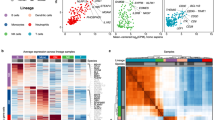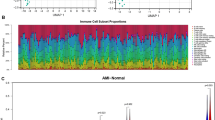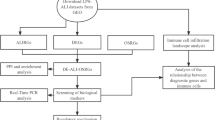Abstract
Gene expression can be regulated by chromatin modifiers, transcription factors and proteins that modulate DNA architecture. Among the latter, AT-hook transcription factors have emerged as multifaceted regulators that can activate or repress broad A/T-rich gene networks. Thus, alterations of AT-hook genes could affect the transcription of multiple genes causing global cell dysfunction. Here we report that targeted deletions of mouse AKNA, a hypothetical AT-hook-like transcription factor, sensitize mice to pathogen-induced inflammation and cause sudden neonatal death. Compared with wild-type littermates, AKNA KO mice appeared weak, failed to thrive and most died by postnatal day 10. Systemic inflammation, predominantly in the lungs, was accompanied by enhanced leukocyte infiltration and alveolar destruction. Cytologic, immunohistochemical and molecular analyses revealed CD11b+Gr1+ neutrophils as major tissue infiltrators, neutrophilic granule protein, cathelin-related antimicrobial peptide and S100A8/9 as neutrophil-specific chemoattracting factors, interleukin-1β and interferon-γ as proinflammatory mediators, and matrix metalloprotease 9 as a plausible proteolytic trigger of alveolar damage. AKNA KO bone marrow transplants in wild-type recipients reproduced the severe pathogen-induced reactions and confirmed the involvement of neutrophils in acute inflammation. Moreover, promoter/reporter experiments showed that AKNA could act as a gene repressor. Our results support the concept of coordinated pathway-specific gene regulation functions modulating the intensity of inflammatory responses, reveal neutrophils as prominent mediators of acute inflammation and suggest mechanisms underlying the triggering of acute and potentially fatal immune reactions.
Similar content being viewed by others
Log in or create a free account to read this content
Gain free access to this article, as well as selected content from this journal and more on nature.com
or
References
Manavathi B, Kumar R . Metastasis tumor antigens, an emerging family of multifaceted master coregulators. J Biol Chem 2007; 282:1529–1533.
Hartmann C . Transcriptional networks controlling skeletal development. Curr Opin Genet Dev 2009; 19:437–443.
Ng KH, Yu H, Ito T . AGAMOUS controls GIANT KILLER, a multifunctional chromatin modifier in reproductive organ patterning and differentiation. PLoS Biol 2009; 7:e1000251.
Aravind L, Landsman D . AT-hook motifs identified in a wide variety of DNA-binding proteins. Nucleic Acids Res 1998; 26:4413–4421.
Reeves R . Molecular biology of HMGA proteins: hubs of nuclear function. Gene 2001; 277:63–81.
Aulner N, Monod C, Mandicourt G, et al. The AT-hook protein D1 is essential for Drosophila melanogaster development and is implicated in position-effect variegation. Mol Cell Biol 2002; 22:1218–1232.
Rekdal C, Sjottem E, Johansen T . The nuclear factor SPBP contains different functional domains and stimulates the activity of various transcriptional activators. J Biol Chem 2000; 275:40288–40300.
Fedele M, Benvenuto G, Pero R, et al. A novel member of the BTB/POZ family, PATZ, associates with the RNF4 RING finger protein and acts as a transcriptional repressor. J Biol Chem 2000; 275:7894–7901.
Siddiqa A, Sims-Mourtada JC, Guzman-Rojas L, et al. Regulation of CD40 and CD40 ligand by the AT-hook transcription factor AKNA. Nature 2001; 410:383–387.
Torrungruang K, Alvarez M, Shah R, et al. DNA binding and gene activation properties of the Nmp4 nuclear matrix transcription factors. J Biol Chem 2002; 277:16153–16159.
Han HJ, Russo J, Kohwi Y, Kohwi-Shigematsu T . SATB1 reprogrammes gene expression to promote breast tumour growth and metastasis. Nature 2008; 452:187–193.
Thomas JO, Travers AA . HMG1 and 2, and related 'architectural' DNA-binding proteins. Trends Biochem Sci 2001; 26:167–174.
Cui T, Leng F . Specific recognition of AT-rich DNA sequences by the mammalian high mobility group protein AT-hook 2: a SELEX study. Biochemistry 2007; 46:13059–13066.
Whitson RH, Tsark W, Huang TH, Itakura K . Neonatal mortality and leanness in mice lacking the ARID transcription factor Mrf-2. Biochem Biophys Res Commun 2003; 312:997–1004.
Sutherland HG, Newton K, Brownstein DG, et al. Disruption of Ledgf/Psip1 results in perinatal mortality and homeotic skeletal transformations. Mol Cell Biol 2006; 26:7201–7210.
Kubota T, Maezawa S, Koiwai K, Hayano T, Koiwai O . Identification of functional domains in TdIF1 and its inhibitory mechanism for TdT activity. Genes Cells 2007; 12:941–959.
Senthilkumar R, Mishra RK . Novel motifs distinguish multiple homologues of Polycomb in vertebrates: expansion and diversification of the epigenetic toolkit. BMC Genomics 2009; 10:549.
Gordon BR, Li Y, Wang L, et al. Lsr2 is a nucleoid-associated protein that targets AT-rich sequences and virulence genes in Mycobacterium tuberculosis. Proc Natl Acad Sci USA 2010; 107:5154–5159.
Sims-Mourtada JC, Bruce S, McKeller MR, et al. The human AKNA gene expresses multiple transcripts and protein isoforms as a result of alternative promoter usage, splicing, and polyadenylation. DNA Cell Biol 2005; 24:325–338.
Thye T, Burchard GD, Nilius M, Muller-Myhsok B, Horstmann RD . Genomewide linkage analysis identifies polymorphism in the human interferon-gamma receptor affecting Helicobacter pylori infection. Am J Hum Genet 2003; 72:448–453.
Landvik NE, Hart K, Skaug V, et al. A specific interleukin-1B haplotype correlates with high levels of IL1B mRNA in the lung and increased risk of non-small cell lung cancer. Carcinogenesis 2009; 30:1186–1192.
Savas S, Liu G . Genetic variations as cancer prognostic markers: review and update. Hum Mutat 2009; 30:1369–1377.
Perales G, Burguete-Garcia AI, Dimas J, et al. A polymorphism in the AT-hook motif of the transcriptional regulator AKNA is a risk factor for cervical cancer. Biomarkers; 15:470–474.
Helmrich A, Stout-Weider K, Hermann K, Schrock E, Heiden T . Common fragile sites are conserved features of human and mouse chromosomes and relate to large active genes. Genome Res 2006; 16:1222–1230.
Neptune ER, Podowski M, Calvi C, et al. Targeted disruption of NeuroD, a proneural bHLH factor, impairs distal lung formation and neuroendocrine morphology in the neonatal lung. J Biol Chem 2008; 283:21160–21169.
Tipple TE, Welty SE, Nelin LD, Hansen JM, Rogers LK . Alterations of the thioredoxin system by hyperoxia: implications for alveolar development. Am J Respir Cell Mol Biol 2009; 41:612–619.
Chen H, Zhuang F, Liu YH, et al. TGF-beta receptor II in epithelia versus mesenchyme plays distinct roles in the developing lung. Eur Respir J 2008; 32:285–295.
Henson PM, Vandivier RW, Douglas IS . Cell death, remodeling, and repair in chronic obstructive pulmonary disease? Proc Am Thorac Soc 2006; 3:713–717.
Xu J, Gao XP, Ramchandran R, et al. Nonmuscle myosin light-chain kinase mediates neutrophil transmigration in sepsis-induced lung inflammation by activating beta2 integrins. Nat Immunol 2008; 9:880–886.
Shvedova AA, Kisin ER, Murray AR, et al. Increased accumulation of neutrophils and decreased fibrosis in the lung of NADPH oxidase-deficient C57BL/6 mice exposed to carbon nanotubes. Toxicol Appl Pharmacol 2008; 231:235–240.
Schymeinsky J, Mocsai A, Walzog B . Neutrophil activation via beta2 integrins (CD11/CD18): molecular mechanisms and clinical implications. Thromb Haemost 2007; 98:262–273.
Laubitz D, Larmonier CB, Bai A, et al. Colonic gene expression profile in NHE3-deficient mice: evidence for spontaneous distal colitis. Am J Physiol Gastrointest Liver Physiol 2008; 295:G63–G77.
Morris DG, Huang X, Kaminski N, et al. Loss of integrin alpha(v)beta6-mediated TGF-beta activation causes Mmp12-dependent emphysema. Nature 2003; 422:169–173.
Shukla A, Barrett TF, Nakayama KI, et al. Transcriptional up-regulation of MMP12 and MMP13 by asbestos occurs via a PKCdelta-dependent pathway in murine lung. FASEB J 2006; 20:997–999.
Nair RR, Solway J, Boyd DD . Expression cloning identifies transgelin (SM22) as a novel repressor of 92-kDa type IV collagenase (MMP-9) expression. J Biol Chem 2006; 281:26424–26436.
Shapiro SD, Goldstein NM, Houghton AM, et al. Neutrophil elastase contributes to cigarette smoke-induced emphysema in mice. Am J Pathol 2003; 163:2329–2335.
Lappalainen U, Whitsett JA, Wert SE, Tichelaar JW, Bry K . Interleukin-1beta causes pulmonary inflammation, emphysema, and airway remodeling in the adult murine lung. Am J Respir Cell Mol Biol 2005; 32:311–318.
O'Donnell LC, Druhan LJ, Avalos BR . Molecular characterization and expression analysis of leucine-rich alpha2-glycoprotein, a novel marker of granulocytic differentiation. J Leukoc Biol 2002; 72:478–485.
Gallo RL, Kim KJ, Bernfield M, et al. Identification of CRAMP, a cathelin-related antimicrobial peptide expressed in the embryonic and adult mouse. J Biol Chem 1997; 272:13088–13093.
Kurosaka K, Chen Q, Yarovinsky F, Oppenheim JJ, Yang D . Mouse cathelin-related antimicrobial peptide chemoattracts leukocytes using formyl peptide receptor-like 1/mouse formyl peptide receptor-like 2 as the receptor and acts as an immune adjuvant. J Immunol 2005; 174:6257–6265.
Newton RA, Hogg N . The human S100 protein MRP-14 is a novel activator of the beta 2 integrin Mac-1 on neutrophils. J Immunol 1998; 160:1427–1435.
Yan C, Wang H, Boyd DD . KiSS-1 represses 92-kDa type IV collagenase expression by down-regulating NF-kappa B binding to the promoter as a consequence of Ikappa Balpha -induced block of p65/p50 nuclear translocation. J Biol Chem 2001; 276:1164–1172.
Fulurija A, Ashman RB, Papadimitriou JM . Neutrophil depletion increases susceptibility to systemic and vaginal candidiasis in mice, and reveals differences between brain and kidney in mechanisms of host resistance. Microbiology 1996; 142:3487–3496.
Knuefermann P, Baumgarten G, Koch A, et al. CpG oligonucleotide activates Toll-like receptor 9 and causes lung inflammation in vivo. Respir Res 2007; 8:72.
Nakae S, Asano M, Horai R, Sakaguchi N, Iwakura Y . IL-1 enhances T cell-dependent antibody production through induction of CD40 ligand and OX40 on T cells. J Immunol 2001; 167:90–97.
Christensen KL, Patrick AN, McCoy EL, Ford HL . The six family of homeobox genes in development and cancer. Adv Cancer Res 2008; 101:93–126.
Mouri F, Tsukada J, Mizobe T, et al. Intracellular HMGB1 transactivates the human IL1B gene promoter through association with an Ets transcription factor PU.1. Eur J Haematol 2008; 80:10–19.
Grant MA, Baron RM, Macias AA, et al. Netropsin improves survival from endotoxaemia by disrupting HMGA1 binding to the NOS2 promoter. Biochem J 2009; 418:103–112.
Sato H, Kita M, Seiki M . v-Src activates the expression of 92-kDa type IV collagenase gene through the AP-1 site and the GT box homologous to retinoblastoma control elements. A mechanism regulating gene expression independent of that by inflammatory cytokines. J Biol Chem 1993; 268:23460–23468.
Lebedeva TV, Singh AK . Constitutive activity of the murine IL-1 beta promoter is regulated by a transcriptional repressor. Biochim Biophys Acta 1997; 1353:32–38.
Lee DU, Avni O, Chen L, Rao A . A distal enhancer in the interferon-gamma (IFN-gamma) locus revealed by genome sequence comparison. J Biol Chem 2004; 279:4802–4810.
Elloumi HZ, Holland SM . Complex regulation of human cathelicidin gene expression: novel splice variants and 5'UTR negative regulatory element. Mol Immunol 2008; 45:204–217.
Nacken W, Lekstrom-Himes JA, Sorg C, Manitz MP . Molecular analysis of the mouse S100A9 gene and evidence that the myeloid specific transcription factor C/EBPepsilon is not required for the regulation of the S100A9/A8 gene expression in neutrophils. J Cell Biochem 2001; 80:606–616.
Resar LM . The high mobility group A1 gene: transforming inflammatory signals into cancer? Cancer Res 2010; 70:436–439.
Fedele M, Fidanza V, Battista S, et al. Haploinsufficiency of the Hmga1 gene causes cardiac hypertrophy and myelo-lymphoproliferative disorders in mice. Cancer Res 2006; 66:2536–2543.
Nagarkar DR, Wang Q, Shim J, et al. CXCR2 is required for neutrophilic airway inflammation and hyperresponsiveness in a mouse model of human rhinovirus infection. J Immunol 2009; 183:6698–6707.
Blood-Siegfried J . The role of infection and inflammation in sudden infant death syndrome. Immunopharmacol Immunotoxicol 2009; 31:516–523.
Bauer AK, Rondini EA . Review paper: the role of inflammation in mouse pulmonary neoplasia. Vet Pathol 2009; 46:369–390.
Ardi VC, Kupriyanova TA, Deryugina EI, Quigley JP . Human neutrophils uniquely release TIMP-free MMP-9 to provide a potent catalytic stimulator of angiogenesis. Proc Natl Acad Sci USA 2007; 104:20262–20267.
Wood LJ, Maher JF, Bunton TE, Resar LM . The oncogenic properties of the HMG-I gene family. Cancer Res 2000; 60:4256–4261.
Wood LJ, Mukherjee M, Dolde CE, et al. HMG-I/Y, a new c-Myc target gene and potential oncogene. Mol Cell Biol 2000; 20:5490–5502.
Xu Y, Sumter TF, Bhattacharya R, et al. The HMG-I oncogene causes highly penetrant, aggressive lymphoid malignancy in transgenic mice and is overexpressed in human leukemia. Cancer Res 2004; 64:3371–3375.
Blackburn MR, Volmer JB, Thrasher JL, et al. Metabolic consequences of adenosine deaminase deficiency in mice are associated with defects in alveogenesis, pulmonary inflammation, and airway obstruction. J Exp Med 2000; 192:159–170.
Acknowledgements
We thank Dr Shao-Cong Sun and Dr Yong-Jun Liu (The University of Texas MD Anderson Cancer Center, USA) for their critiques and advice. We also thank Dr Douglas D Boyd (The University of Texas MD Anderson Cancer Center, USA) and Dr Richard L Gallo (University of California, San Diego, USA) for their generosity in providing the MMP9 promoter/Luciferase reporter and the anti-CRAMP antibody, respectively. The present work was supported by grants AI056125-01 and AI065796-01 from the National Institutes of Health (NIH) and by NCI CCSG Core grant CA106672. MRM was supported by the training grant T32 CA009598-15 from the NIH and WM was supported by the Odyssey Program and The Cockrell Foundation Award for Scientific Achievement at The University of Texas MD Anderson Center Cancer.
Author information
Authors and Affiliations
Corresponding author
Additional information
( Supplementary information is linked to the online version of the paper on the Cell Research website.)
Supplementary information
Supplementary information, Figure S1
AKNA Genotype and expression analyses. (PDF 1205 kb)
Supplementary information, Figure S2
Comparative assessment of alveolar airspace. (PDF 62 kb)
Supplementary information, Figure S3
Lung Elastin deposit, cytokine expression and apoptosis. (PDF 16935 kb)
Supplementary information, Figure S4
Circulating lymphocytes and lung cytokine expression. (PDF 89 kb)
Rights and permissions
About this article
Cite this article
Ma, W., Ortiz-Quintero, B., Rangel, R. et al. Coordinate activation of inflammatory gene networks, alveolar destruction and neonatal death in AKNA deficient mice. Cell Res 21, 1564–1577 (2011). https://doi.org/10.1038/cr.2011.84
Received:
Revised:
Accepted:
Published:
Issue date:
DOI: https://doi.org/10.1038/cr.2011.84
Keywords
This article is cited by
-
An Amish founder population reveals rare-population genetic determinants of the human lipidome
Communications Biology (2022)
-
An exome-first approach to aid in the diagnosis of primary ciliary dyskinesia
Human Genetics (2020)
-
Effects of a Single Head Exposure to GSM-1800 MHz Signals on the Transcriptome Profile in the Rat Cerebral Cortex: Enhanced Gene Responses Under Proinflammatory Conditions
Neurotoxicity Research (2020)
-
The association of AKNA gene polymorphisms with knee osteoarthritis suggests the relevance of this immune response regulator in the disease genetic susceptibility
Molecular Biology Reports (2018)
-
Cervical cancer-associated promoter polymorphism affects akna expression levels
Genes & Immunity (2015)



